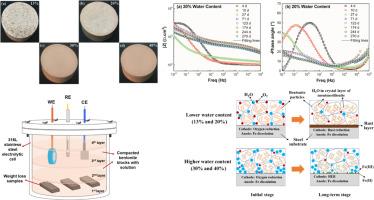含水量对嵌入压实 GMZ 膨润土中的镍铜低合金钢腐蚀行为的影响
IF 11.2
1区 材料科学
Q1 MATERIALS SCIENCE, MULTIDISCIPLINARY
引用次数: 0
摘要
缓冲材料和金属处置容器是高放射性废物地质处置的关键工程屏障。处置容器的耐久性在很大程度上取决于缓冲材料中的含水量。这项工作的重点是利用失重法、电化学测量法和各种腐蚀产物分析方法,研究镍铬低合金钢在不同含水量的压实 GMZ 膨润土中 270 d 的腐蚀演变过程。随着含水量从 13% 增加到 20%,膨润土中的水从不饱和状态转变为临界饱和状态,镍铬钢的腐蚀速率明显增加。在这两个体系中,氧气可以通过膨润土中的气孔以气相迁移到钢表面的薄液膜中,并发生阴极还原。同时,它将铁水解产物氧化成铁腐蚀产物,并形成锈层,从而阻碍氧气的扩散。此时,镍铜钢腐蚀的阴极过程转变为锈还原过程。当含水量持续增加到 30% 和 40% 时,压实膨润土处于饱和状态,镍铜钢的腐蚀速率显著下降。这是因为膨润土颗粒间的大部分孔隙被大量游离水占据,阻碍了氧气的扩散,抑制了氧气的阴极还原。此外,它还抑制了铁腐蚀产物的氧化,从而大大削弱了铁锈的阴极去极化作用,导致阴极过程以氢进化反应为主。本文章由计算机程序翻译,如有差异,请以英文原文为准。

Effects of water content on the corrosion behavior of NiCu low alloy steel embedded in compacted GMZ bentonite
Buffer material and metal disposal containers are the key engineering barriers in the geological disposal of high-level radioactive waste. The durability of disposal containers largely depends on the water content in buffer material. This work focused on investigating the corrosion evolution of NiCu low alloy steel in compacted GMZ bentonite with different water contents for 270 d by using weight loss, electrochemical measurements, and various methods for analyzing corrosion products. As the water content increased from 13% to 20%, the water in the bentonite transformed from an unsaturated to a critical saturated state, and the corrosion rate of NiCu steel clearly increased. In these two systems, the oxygen could migrate to the thin liquid film on the steel surface through the air pores in the bentonite in the gas phase and undergo cathodic reduction. Meanwhile, it oxidized the ferrous hydrolysis products into ferric corrosion products and formed a rust layer, which could block the diffusion of oxygen. At that moment, the cathodic process of NiCu steel corrosion changed to rust reduction. When the water content continually increased to 30% and 40%, the compacted bentonite was in a saturation state, and the corrosion rate of NiCu steel was significantly decreased. This was because most pores among the bentonite particles were occupied by a large amount of free water, which hindered the diffusion of oxygen and inhibited its cathodic reduction. Furthermore, it restrained the oxidation of ferrous corrosion products, which greatly weakened the cathodic depolarization of rust, leading to the cathodic process being dominated by the hydrogen evolution reaction.
求助全文
通过发布文献求助,成功后即可免费获取论文全文。
去求助
来源期刊

Journal of Materials Science & Technology
工程技术-材料科学:综合
CiteScore
20.00
自引率
11.00%
发文量
995
审稿时长
13 days
期刊介绍:
Journal of Materials Science & Technology strives to promote global collaboration in the field of materials science and technology. It primarily publishes original research papers, invited review articles, letters, research notes, and summaries of scientific achievements. The journal covers a wide range of materials science and technology topics, including metallic materials, inorganic nonmetallic materials, and composite materials.
 求助内容:
求助内容: 应助结果提醒方式:
应助结果提醒方式:


